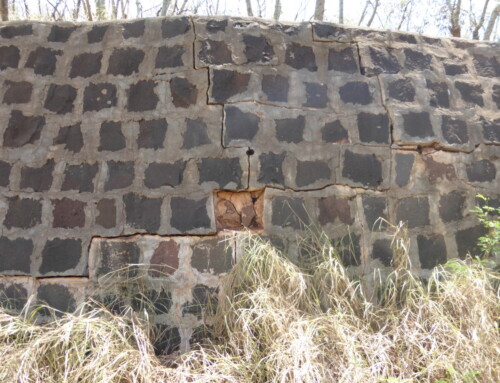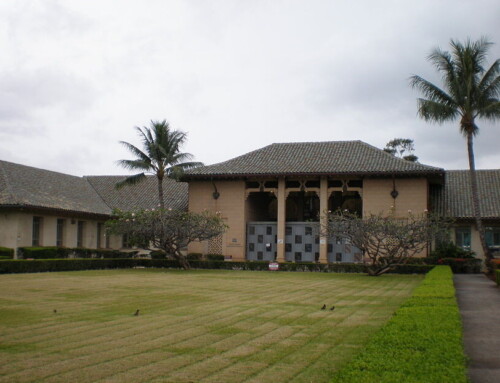Graffiti is not only an irritating eyesore and source of visual blight in our community, but it can be destructive for historic masonry buildings. The key to eliminating graffiti—and preventing it from reoccurring—is to remove graffiti as soon as it appears.
Spray paints are the most common type of graffiti, but solvents and paint strippers capable of removing spray paints are harsh and abrasive, may discolor or stain masonry surfaces, make it more difficult to remove paint, and potentially damage the masonry. There are ways to remove graffiti, however, from all types of historic masonry without damaging the historic surface or substrate by breaking the bond between the paint and the masonry surface. This requires knowledge of 1) the materials used to make graffiti, 2) the masonry, and 3) cleaning methods and materials.
The first step is to identify the type of paint. The most common graffiti materials are spray paints (Polyurethanes, lacquers, and enamels); brush-applied paints (oils and synthetic resins such as vinyls, acrylics, acetates, methacrylates, or alkyds), and permanent felt markers. But other materials can also be used, such as water-soluble felt markers, ballpoint pens, chalk, graphite and colored pencils, pastels, wax and oil crayons, liquid shoe polish, and lipstick. Paints are composed of 1) pigments, 2)binder that holds the pigment together, and 3)a solvent that allows the pigment/binder to flow. They are applied wet and harden as they dry. Therefore, the longer they are allowed to remain on the surface, the harder they are to remove.
The second step to assess the condition of the historic masonry prior to beginning graffiti removal. Masonry encompasses all types of natural stones; manufactured clay materials such as brick; and cementitious materials such as cast stone, concrete and mortar. The common factor they share is that they are porous and sensitive to abrasion, particularly if it is fragile or permeable. Some smooth, polished surfaces can be relatively easy to clean, while weathered, rough surfaces can be nearly impossible to clean even with a bristle brush without risking severe surface loss.
The difference in surface texture or finish may be the reason to select one particular cleaning agent over another. Masonry will react differently to various cleaning agents. For the purpose of cleaning, masonry is categorized according to 1) acid-sensitive, 2) non-acid sensitive, or 3) alkali-sensitive. Acid-sensitive materials include limestone, marble, travertine, calcareous sandstones and shales; most polished stones; glazed terra cotta and glazed brick. Non-acid sensitive masonry materials include slate, granite, unglazed terra cotta and unglazed brick. Alkali-sensitive stones include some granites, Indiana limestone, and many types of sandstone.
Treatments for the removal of graffiti are then chosen to minimize damage to the historic masonry. Successful graffiti removal often requires a combination of cleaning materials and methods. Treatment options range from soft brushes for chalked graffiti to poulticing with water (with or without detergents), poulticing with organic solvents or alkali-based paint removers, or applying bleach to remove painted graffiti. A poultice consists of an absorbent material or powder—inert clays or cellulose products such as shredded paper—mixed with a cleaning solution to form a paste. It enables the cleaning solution to be kept in contact with the stained area as long as possible and is often covered with a plastic sheet to keep it from drying out. Always begin with the gentlest means possible, which may include low-pressure water washing. Ammonia can also be effective in removing fresh graffiti.
Always test a detergent first because most laundry detergents are not neutral and may leave residues. Most graffiti can be removed without damaging masonry with proprietary graffiti-removal products and commercial paint strippers containing organic solvents. Always test these first. Apply these products in a poultice to prevent them from penetrating into the substrate. Abrasive treatments should never be used except in some conditions a micro-abrasive technique used at low pressure. Laser technology offers great promise in the future.
Physical barrier coatings can be applied to facilitate removal of graffiti from masonry surfaces. These coatings are typically transparent but may be tinted. Although barrier coatings seem to offer an easy preventive solution, they do not always work and may sometimes cause changes or damage to the masonry. They generally are not recommended for use on historic masonry, unless the graffiti problem is severe.
Rapid graffiti removal is the most effective weapon in eliminating graffiti. Be prepared by testing different cleaning techniques and developing a treatment plan in advance. Use a trained maintenance worker who understands how to select the most appropriate and sensitive cleaning technique and will take health and safety and environmental precautions in handling the cleaning products. Apart from removal, effective graffiti-prevention includes maintenance, lighting, security, and barriers on or around the property. Effective prevention should also carry out community awareness programs, neighborhood patrols, community service programs and educational programs in the schools.
For more information, see Martin E. Weaver, Preservation Brief 38: Removing Graffiti from Historic Masonry, National Park Service.





